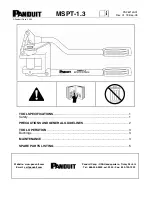
-18-
Model t10222 (Mfg. since 12/09)
4. Cut an outline of the spindle and cutter from
the center of the stock selected in
Step 3, as
illustrated in
figure 25.
Note:
Make the outline as close as possible
to the cutter and spindle without interfering
with rotation.
Zero-Clearance Fence
Cutter
Table
Mounting
Fastener
figure 25. Example of a zero-clearance fence.
5. Create countersunk mounting holes in the
zero-clearance fence so that the screws and
t-nuts removed from the split fence can be
used to secure the new fence to the fence
assembly in the same manner.
ALWAYS use hold-downs or featherboards
and push sticks when shaping small or nar
-
row stock. These devices keep your hands
away from the spinning cutter and suffi
-
ciently support the stock to allow a safe and
effective cut, reducing the risk of personal
injury.
6. secure the zero-clearance fence to the fence
assembly, check for proper clearance, con-
nect the router to power, then run a test piece
by the cutter to verify the results.
Free-Hand Routing
irregular or free-hand routing, as illustrated in
figure 26, takes a high degree of skill and dexter-
ity and is done without the protection and aid from
the fence and guard. the most dangerous part
of free-hand routing is beginning the cut, when
the cutter first contacts the workpiece. often the
workpiece will tend to jerk or kickback, presenting
an injury hazard to the operator.
free
-
hand or irregular routing greatly
increases the chance that the operator may
lose control of the workpiece, which could
result in serious personal injury. Therefore,
a starting pin or block and a custom guard
or workpiece holding jig MUST be used.
Workpiece
Feed Direction
Swing
Starting Pin
Rub
Collar
Ro
tation
figure 26. illustration of free-hand routing using
a starting pin (guard not shown for clarity).









































